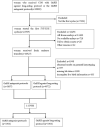An Individualized Recommendation for Controlled Ovary Stimulation Protocol in Women Who Received the GnRH Agonist Long-Acting Protocol or the GnRH Antagonist Protocol: A Retrospective Cohort Study
- PMID: 35937797
- PMCID: PMC9355571
- DOI: 10.3389/fendo.2022.899000
An Individualized Recommendation for Controlled Ovary Stimulation Protocol in Women Who Received the GnRH Agonist Long-Acting Protocol or the GnRH Antagonist Protocol: A Retrospective Cohort Study
Abstract
Background: The GnRH agonist long-acting protocol and GnRH antagonist protocol are widely used in ovarian stimulation. Which protocol eliciting higher live birth rate for IVF/ICSI patients with different ages, different ovarian reserves and different body mass index (BMI) has not been studied. However, among these protocols, the one that elicits higher live birth in IVF/ICSI patients with different ages, ovarian reserves and body mass indexes (BMI) has not been identified.
Methods: This was a retrospective cohort study about 8579 women who underwent the first IVF-ET from January, 2018 to August, 2021. Propensity Score Matching (PSM) was used to improve the comparability between two protocols.
Results: After PSM, significant higher live birth rates were found in the GnRH agonist long-acting protocol compared to GnRH antagonist protocol (44.04% vs. 38.32%) (p<0.001). Stratified analysis showed that for those with AMH levels between 3 ng/ml and 6 ng/ml, with BMI ≥ 24 kg/m2 and were aged ≥ 30 years old, and for those women with BMI < 24kg/m2 and were aged ≥30 years whose AMH levels were ≤ 3ng/ml, the GnRH agonist long-acting protocol was more likely to elicit live births [OR (95%CI), 2.13(1.19,3.80)], [OR (95%CI), 1.41(1.05,1.91)]. However, among women with BMI ≥ 24kg/m2 and were aged ≥30 years whose AMH levels were ≤ 3ng/ml, the GnRH agonist long-acting protocol had a lower possibility of eliciting live births [OR (95%CI), 0.54(0.32,0.90)]. Also, among women with AMH levels between 3 ng/ml and 6 ng/ml, with BMI ≥ 24 kg/m2 and with age < 30 years and for those with AMH levels between 3 ng/ml and 6 ng/ml, regardless of age, and with BMI<24kg/m2,, the possibility of live births was similar between the two protocols [OR (95%CI), 1.06(0.60,1.89)], [OR (95%CI), 1.38(0.97,1.97)], [OR (95%CI), 0.99(0.72,1.37)]. Among the women with AMH levels ≤ 3 ng/ml and with were aged < 30years, regardless of BMI, the possibility of live birth was similar between the two protocols [OR (95%CI), 1.02(0.68,1.54)], [OR (95%CI), 1.43(0.68,2.98)]. Moreover, among women with AMH levels ≥ 6ng/ml, the possibility of live birth was similar between the two protocols [OR (95%CI),1.42(0.75,2.69)], [OR (95%CI),1.02(0.19,5.35)], [OR (95%CI), 1.68(0.81,3.51)], [OR (95%CI), 0.51(0.10,2.55)].
Conclusions: The suitability of the GnRH agonist long-acting protocol or GnRH antagonist protocol to infertility patients is dependent on specific biological characteristics of the patients.
Keywords: GnRH agonist long-acting protocol; GnRH antagonist protocol; body mass index; live birth rate; ovarian reserve.
Copyright © 2022 Chen, Meng, Zhong, Tang, Li, Feng, Adu-Gyamfi, Jia, Lv, Geng, Zhu, He, Wan and Ding.
Conflict of interest statement
The authors have no conflict of interest to declare.
Similar articles
-
Comparison of clinical effects between early follicular prolonged GnRH agonist protocol and GnRH antagonist protocol in 3310 cycles: a retrospective study.BMC Pregnancy Childbirth. 2022 Dec 15;22(1):942. doi: 10.1186/s12884-022-05295-6. BMC Pregnancy Childbirth. 2022. PMID: 36522703 Free PMC article.
-
Comparison of pregnancy outcomes between GnRH antagonist protocol with freeze-all strategy and long-acting GnRH agonist protocol in women with adenomyosis undergoing IVF/ICSI: a propensity-score matching analysis.BMC Pregnancy Childbirth. 2022 Dec 17;22(1):946. doi: 10.1186/s12884-022-05276-9. BMC Pregnancy Childbirth. 2022. PMID: 36528566 Free PMC article.
-
Analysis of cumulative live birth rate and perinatal outcomes in young patients with low anti-müllerian hormone levels using two ovulation promotion protocols: A cohort study.Front Endocrinol (Lausanne). 2022 Aug 5;13:938500. doi: 10.3389/fendo.2022.938500. eCollection 2022. Front Endocrinol (Lausanne). 2022. PMID: 35992097 Free PMC article.
-
Efficacy of three COS protocols and predictability of AMH and AFC in women with discordant ovarian reserve markers: a retrospective study on 19,239 patients.J Ovarian Res. 2021 Aug 28;14(1):111. doi: 10.1186/s13048-021-00863-4. J Ovarian Res. 2021. PMID: 34454544 Free PMC article.
-
Conventional GnRH antagonist protocols versus long GnRH agonist protocol in IVF/ICSI cycles of polycystic ovary syndrome women: a systematic review and meta-analysis.Sci Rep. 2022 Mar 15;12(1):4456. doi: 10.1038/s41598-022-08400-z. Sci Rep. 2022. PMID: 35292717 Free PMC article.
Cited by
-
Effect of BMI on cumulative live birth rates in patients that completed IVF treatment: a retrospective cohort study of 16,126 patients.Endocr Connect. 2024 Jan 31;13(3):e230105. doi: 10.1530/EC-23-0105. Print 2024 Mar 1. Endocr Connect. 2024. PMID: 38197872 Free PMC article.
-
Comparison of clinical effects between early follicular prolonged GnRH agonist protocol and GnRH antagonist protocol in 3310 cycles: a retrospective study.BMC Pregnancy Childbirth. 2022 Dec 15;22(1):942. doi: 10.1186/s12884-022-05295-6. BMC Pregnancy Childbirth. 2022. PMID: 36522703 Free PMC article.
-
Prospective application of a prediction model for lateral lymph node metastasis in papillary thyroid cancer patients with central lymph node metastasis.Front Endocrinol (Lausanne). 2024 Jan 4;14:1283409. doi: 10.3389/fendo.2023.1283409. eCollection 2023. Front Endocrinol (Lausanne). 2024. PMID: 38239987 Free PMC article.
-
Clinical data-based modeling of IVF live birth outcome and its application.Reprod Biol Endocrinol. 2024 Jul 8;22(1):76. doi: 10.1186/s12958-024-01253-3. Reprod Biol Endocrinol. 2024. PMID: 38978032 Free PMC article.
-
Young obese patients may benefit from GnRH-a long protocol contributing to higher implantation rate and live birth rate of fresh IVF-ET cycles.Heliyon. 2023 Sep 20;9(10):e20016. doi: 10.1016/j.heliyon.2023.e20016. eCollection 2023 Oct. Heliyon. 2023. PMID: 37810820 Free PMC article.
References
Publication types
MeSH terms
Substances
LinkOut - more resources
Full Text Sources
Miscellaneous


